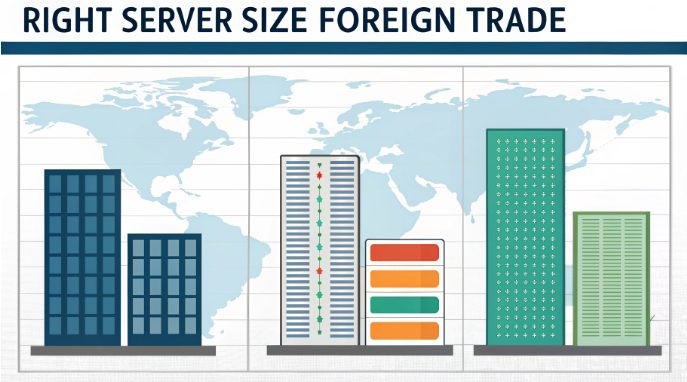How to Choose the Right Server Size for a Foreign Trade Site

Selecting the right server configuration for your e-commerce website is crucial for maintaining optimal performance and ensuring scalability. As tech professionals venturing into global e-commerce, understanding server specifications and server hosting requirements becomes a critical factor in your success equation.
Key Factors Influencing Server Selection
When architecting your e-commerce infrastructure, several technical parameters demand careful consideration. Let’s dive deep into the metrics that matter:
- Traffic patterns and bandwidth requirements
- Database size and query complexity
- Concurrent user capacity
- Content delivery requirements
- Security protocol overhead
Technical Specifications for Entry-Level E-commerce
For nascent e-commerce operations, here’s a technical breakdown of recommended specifications:
- CPU: 2-4 cores (Intel Xeon or AMD EPYC)
- RAM: 8-16GB DDR4
- Storage: 100GB SSD (NVMe preferred)
- Bandwidth: 5-10TB monthly transfer
- Connection: 1Gbps port
These specifications provide a solid foundation for sites handling up to 10,000 monthly visitors with a product database of approximately 5,000 SKUs.
Mid-Tier E-commerce Platform Requirements
As your digital footprint expands, your infrastructure needs to evolve. Here’s what a growing e-commerce platform typically requires:
- CPU: 8-16 cores with advanced threading capabilities
- RAM: 32-64GB ECC memory
- Storage: 500GB-1TB NVMe SSD in RAID configuration
- Bandwidth: 20-30TB monthly transfer
- Connection: 10Gbps port with redundancy
Performance Monitoring Metrics
Implementing robust monitoring systems is essential for maintaining optimal server performance. Focus on these key metrics:
- Server Response Time (SRT)
- Target: < 200ms for API calls
- Peak load handling capacity
- Geographic response variations
- Resource Utilization
- CPU usage patterns
- Memory consumption trends
- I/O performance metrics
- Error Rate Monitoring
- 404/500 error frequency
- Database timeout incidents
- Connection pool saturation
US Hosting Advantages for Global E-commerce
Selecting US-based hosting infrastructure offers several technical advantages:
- Geographic load balancing with major CDN providers
- Direct peering with major network backbones
- Advanced DDoS protection capabilities
- GDPR and data privacy compliance options
- 24/7 technical support with minimal language barriers
The strategic placement of servers in key US data centers can significantly reduce latency for global traffic, particularly when leveraging edge computing capabilities.
Common Technical Pitfalls to Avoid
When architecting your e-commerce infrastructure, be wary of these technical misconceptions:
- Overprovisioning resources without load testing validation
- Neglecting backup and disaster recovery protocols
- Implementing caching strategies without proper benchmarking
- Overlooking security hardening measures
Scaling Indicators and Upgrade Timing
Monitor these technical indicators to determine when to scale your infrastructure:
- Performance Metrics
- CPU utilization consistently above 70%
- Memory usage exceeding 80% during peak hours
- Disk I/O queues growing beyond acceptable thresholds
- Business Growth Indicators
- Monthly traffic increase of 25% or more
- Database size growing by 50% quarterly
- Concurrent user sessions reaching platform limits
Technical Recommendations and Best Practices
Implement these technical best practices for optimal e-commerce hosting:
- Deploy containerized applications for better resource utilization
- Implement automated scaling policies based on usage patterns
- Utilize server-side caching with Redis or Memcached
- Configure CDN for static asset delivery
- Regular performance audits and optimization cycles
Cost-Benefit Analysis of Server Configurations
Consider these factors when evaluating hosting investments:
- Total Cost of Ownership (TCO) calculations
- Performance gains vs. infrastructure costs
- Scalability requirements and associated expenses
- Support and maintenance overhead
Conclusion
Selecting the appropriate server configuration for your e-commerce platform requires careful consideration of technical specifications, performance requirements, and scalability needs. By focusing on key performance metrics and understanding hosting requirements, you can build a robust infrastructure that supports your business growth while maintaining optimal performance and cost-efficiency.
Remember that server configuration is not a one-time decision but an evolving process that requires regular monitoring and adjustment based on your e-commerce platform’s growth and performance needs. Whether you’re starting with basic hosting solutions or scaling to enterprise-level configurations, maintaining focus on performance, security, and scalability will ensure long-term success.

